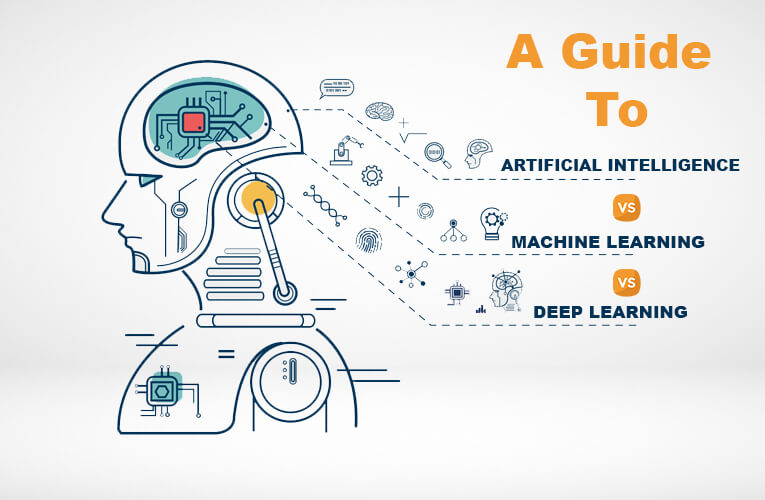Artificial intelligence was provided every day in 2021, with music recommender, Google Maps, Uber, and many other applications being operated by AI. Yet uncertainty exists between terms artificial understanding, machine learning, and profound learning. One of Google’s common search requirements is: “Are artificial intelligence and engine learning the same thing?”
Let’s clear things up: artificial intelligence (AI), machine learning (ML), and deep learning (DL) are three different things.
Today many misunderstandings include machine learning, deep learning, and artificial intelligence(AI). Once they hear the word AI, most people believe these things are the same, they explicitly compare it to machine learning or vice versa, well yeah, they are interrelated, but not the same. We’re going to see how.
Artificial intelligence
Science like mathematics or biology is artificial intelligence! It explores ways of developing intelligent programs and machinery to solve problems creatively which have long been regarded as human prerogatives.
Now when we speak of AI, it’s a separate matter from Machine learning and profound learning deep learning and Machine learning are the two parts of AI. There’s no defined AI definition, but everywhere there’s no other definition, but here’s a definition that gives you an idea of the exact nature of AI.

“AI is the ability of computer program to function like a human brain ”
AI means that a human brain, the way a human brain thinks, operates, and works are simply replicated. The fact is that until now, we can’t establish a correct AI but are close to establishing it. Sophia, the most advanced AI model available today, is one example of AI. The explanation why we can’t get the right AI up to now is that we do not understand several facets of the human brain until now, why are we dreaming? etc.
Both artificial intelligence systems, actual and hypothetical, fall into one of three categories using these characteristics as a reference:
- Artificial narrow intelligence (ANI): Artificial narrow intelligence (ANI), also referred to as weak AI or narrow AI, is the only type of artificial intelligence we have successfully realized to date. Narrow AI is goal-oriented, designed to perform singular tasks – i.e. facial recognition, speech recognition/voice assistants, driving a car, or searching the internet – and is very intelligent at completing the specific task it is programmed to do.
- Artificial general intelligence (AGI): The idea of a computer with general intelligence (CGI) which imitates human intelligence and/or behavior, and is capable of learning and applying its intelligence to solve any problem, is also referred to as a powerful AI or deep AI. In any given situation, AGI can think, understand and behave in a way that is incompatible with that of a person.
- Artificial superintelligence (ASI): Artificial super-intelligence is the hypothetical AI that is not merely imitating or understanding human intelligence and behavior. ASI is the AI that makes computers self-aware and overcomes human capability and intelligence. In dystopian science fiction, superintelligence has long been the muse for machines to overwhelm mankind, overthrow, and slave. The principle of artificial superintelligence considers AI to develop in such a way that it does not only understand human emotions and experiences but it also evokes the emotions, needs, values, and desires of the person.
The tasks currently being addressed by data scientists (which can help to develop overall and superintelligence) are:
- Machine Reasoning: For example, a database or library, MR systems have some information at their disposal. They will formulate useful insights based on this knowledge using inference and induction techniques. It may include AI system preparation, data reproduction, search, and optimization.
- Robotics: The sciences focus on the construction, development, and control of robots from Roombas to smart androids.
- Machine Learning: Research algorithms and machine computer models to carry out a specified mission.
They can be called AI development methods. Just one can be used or both in one device together.
Machine Learning
Machine learning is a subset of artificial intelligence (AI) that offers systems the ability to learn from experience automatically and to evolve without being expressly programmed. ML contains various algorithms that contribute to solving problems. There are neural networks.

It allows us to speak about an alternative concept called data mining before talking about machine learning. It is easy to understand, correct, machine learning does the same because machine learning is a sort of data mining technology. Data mining is a technique of analyzing a vast existing base and collecting new knowledge from that database.
Here’s is a basic definition of machine learning –
“Machine Learning is a technique of parsing data, learn from that data and then apply what they have learned to make an informed decision”
Now many major businesses use machine learning to offer consumers a better experience, and Amazon uses machinery training to give customers better product choices based on their preferences; Netflix uses machine learning to give better suggestions or shows for their TV-series users.
To “educate” the machine, you need these 3 components:
- Datasets: Machine learning systems are educated in special sample collections known as datasets. Numbers, photographs, text, or any other data may be included in the samples. It normally takes a lot of time to build a decent dataset.
- Features: Features are vital data items that are the key to the task solution. They show the computer what to look after. How are the features chosen? Let us tell, the price of an apartment you want to estimate. By linear regression, for example, it is difficult to predict how much the site can cost based on the combination of its length and width. However, the correlated price to the area in which the building is situated is much easier to find.
- Algorithm: Different algorithms can solve the same problem. The accuracy or speed of the results will vary, depending on the algorithm. Often you combine various algorithms, as in ensemble learning, to achieve better results.
Any program that uses ML is independent of instructions manually encoded for particular tasks. The machine recognizes trends and predicts useful. If the data set is of high quality and the functions are selected correctly, an ML-capable device can be improved on a specific task rather than humans.
Deep Learning
Deep Learning is a subset of machinery that uses a network of neurons to interpret various factors with an equivalent structure to the human neural system.
Deep learning is a subset of machine learning. It’s machine learning and works the same way theoretically but it’s different.

Machine learning models are becoming more progressing, but the algorithm still requires some guidance. The key difference between deep and machine learning is. If a computer study model returns an erroneous forecast, the programmer needs to specifically correct this problem but the model does it by itself in the case of profound learning. A clear example of profound learning is the automatic car driving system.
Let’s take an example to understand both machine learning and deep learning –
Assume you have a flashlight and we teach a learning machine model that when somebody says “dark,” the flashlight should be on, now the learning model analyzes the phrase of the people and searches for the word dark and as the word comes, it is on the flashlight, but what if someone says “I can’t see anything, light is dim”. This is where deep learning differs from learning by machines. A deep learning model would be able to draw upon its method of computation if it was a profound learning model on a flashlight.
Difference Between Artificial Intelligence vs Machine Learning vs Deep Learning
Artificial Intelligence: The method for incorporating human intelligence into machines through a collection of rules is essentially artificial intelligence (algorithm). AI is a mix of two words: ‘artificial,’ which means something done by people or things not normal, and ‘intelligence’ which means the ability to understand or think accordingly. A further description might be that “AI essentially involves the analysis of your computer’s ability to imitate a human brain. AI focuses on three main aspects: apprenticeship, thinking, and auto-correction to achieve the highest possible performance.
Machine Learning: Machine Learning is essentially the research/method that enables the system to automatically learn on its own through experience and thus progress without being specifically programmed. ML is an AI sub-set or function. ML focuses on program creation so that it can obtain data for itself. Data observations are made during the entire process to identify potential trends and make future decisions, by the example given. ML’s main objective is to allow the system to learn from itself without any human interference or assistance through experience.
Deep Learning: Deep learning is essentially a subpart of the wider machine learning family, which uses neural networks to imitate human brain-like behaviors (as are the neurons functioning in our brain). DL algorithms are designed to recognize patterns in information processing mechanisms, much as our human brain does and categorizes data accordingly. DL works on larger data sets when compared to ML and the machine auto-administers the prediction mechanism.
Below is a table of differences between Artificial Intelligence, Machine Learning, and Deep Learning:
| Artificial Intelligence | Machine Learning | Deep Learning |
| AI is Artificial Intelligence and is primarily a study/process that allows machines to imitate human behavior using a specific algorithm. | This research is based on statistical methods that allow machines to enhance their experience. ML stands for machine learning. | DL is Deep Learning and is used to mimic functionality in the way of a human brain through neural networks, similar to neurons in the human brain. |
| AI is a wider family of components consisting of ML and DL. | ML is the subset of AI. | DL is the subset of ML. |
| AI is a computer algorithm that exhibits intelligence through decision-making. | ML is an AI algorithm that allows the system to learn from data. | DL is an ML algorithm that uses deep(more than one layer) neural networks to analyze data and provide output accordingly. |
| Search Trees and much complex math is involved in AI. | If you are aware of the logic behind it and can view the complex features such as K-Mean, Support Vector Machines, etc. it describes the aspects of ML. This is a straightforward concept. | If you know the mathematics, but don’t know the features, then it sets the DL aspect by breaking complex features into linear/low dimension characteristics by adding more layers. |
| The aim is to increase the chances of success and not accuracy. | The aim is to increase accuracy not caring much about the success ratio. | It attains the highest rank in terms of accuracy when it is trained with a large amount of data. |
| Three broad categories/types Of AI are: Artificial Narrow Intelligence (ANI), Artificial General Intelligence (AGI), and Artificial Super Intelligence (ASI) | Three broad categories/types Of ML are: Supervised Learning, Unsupervised Learning and Reinforcement Learning | DL can be considered as neural networks with a large number of parameters layers lying in one of the four fundamental network architectures: Unsupervised Pre-trained Networks, Convolutional Neural Networks, Recurrent Neural Networks, and Recursive Neural Networks |
| The efficiency Of AI is the efficiency provided by ML and DL respectively. | Less efficient than DL as it can’t work for longer dimensions or a higher amount of data. | More powerful than ML as it can easily work for larger sets of data. |
| Examples of AI applications include: Google’s AI-Powered Predictions, Ridesharing Apps Like Uber and Lyft, Commercial Flights Use an AI Autopilot, etc. | Examples of ML applications include Virtual Personal Assistants: Siri, Alexa, Google, etc., Email Spam, and Malware Filtering. | Examples of DL applications include Sentiment based news aggregation, Image analysis, and caption generation, etc. |
Summing up
There are many good applications for artificial intelligence that change the future of technology. Already, ML helps the machine to overperform us on calculation, pattern recognition, and anomaly detection while building an AI that’s typically as intelligent as man.












